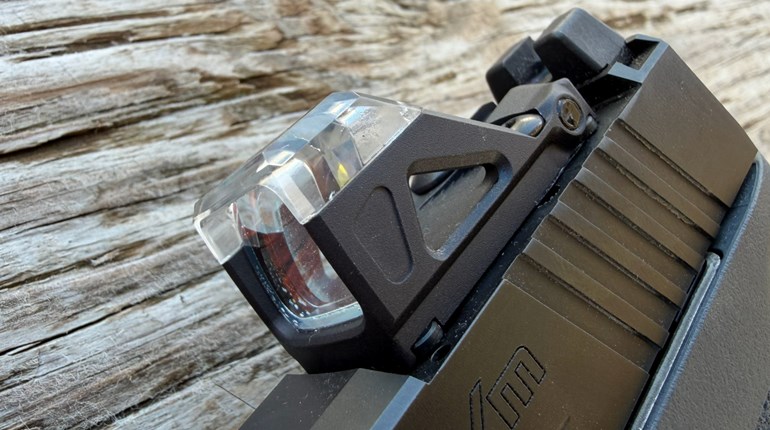
More and more concealed carry pistols are hitting the market “optics-ready.” Some people buy a new gun, some convert their old slide and others look for a pistol with a red-dot sight installed at time of purchase. Is this just a trend or truly beneficial for the shooter?
When shooting with iron sights, it is paramount to focus on the sights. Looking beyond them at the target is a definite no-no. I personally discovered that I tend to focus somewhere between the sights and the target. My eyes wander, and my brain pulls my focus back towards the sights, with the subconscious argument ending somewhere in the middle. This results in fliers and inconsistent shots.
I’ve always found shooting red dots easier, but never really knew why. I also didn’t know whether to focus on the dot or the target. Both seemed to work and I’ve always been taught to focus on the sights, so that’s what I’ve defaulted to. Conversations with some red dot experts changed my perspective.
Experts Weigh In On Red Dot Pistol Sights
Buck Buckner, U.S. Director of Training for Aimpoint, has been using red dots for decades through his experience in the military. “If you focus on the dot,” he said, “you are giving away one of its chief biological advantages…threat focus.”
This made me think. In a defensive situation, it makes most sense to focus on the threat at hand, not to look away. Focusing on the sights makes everything else disappear. While great in competitive shooting, this lack of situational awareness can make a bad situation worse. It isn’t an illusion red dots are often easier to use — in fact, they are superior under stress. “They complement our biology,” Buckner said, “particularly under stress. They make us work less, and give our brain an easier path to a more efficient solution…which is what we are always looking for. If you have one and are working as hard as you were with Irons…you aren’t using it right.” Buckner also noted that simplifying sights leaves room for decision making.

Buckner continued to expand on the science between red dots and irons.
“Think about vision in two different broad categories: ‘Emphatic signal’ and ‘subtle signal’. Subtle signals are things that we have to drive our brain to see, emphatic signals are the opposite. Something in them attracts our eye without the impetus to seek them out. Red dots act as emphatic signals and irons work as subtle signals. We have a great deal of work to do to find irons and then create a spatial solution from them. Much harder than we would like to think under normal circumstances. Under stress…this is exacerbated. The mind becomes infinitely simpler…it wants loud, easily digestible information. That is a red dot.”
Threat Focused or Target Focused?
This opinion isn’t unique to Buckner. Steve Fisher has been a consultant for red-dot manufacturers for several decades. He noted that red-dot pistol sights give the user less to think about visually, allowing more information to be gathered elsewhere. “The person using the red dot no longer has to focus on 3 to 4 things,” Fisher said. “Now only one focus.” Since irons require utmost focus on the sights, many people will shift their view between the threat and the sights. Red dot pistol sights allow the user to do what’s natural, look at the threat and superimpose the dot over what they see.
While threat focus is a huge advantage to red dots, Fisher also noted that they allow for shooting in reduced light and better accuracy for those with eyesight issues. On the downside, red dots require more maintenance than iron sights and can fail. Open emitter red dots especially can fall victim to environmental factors.
Fisher attributes much of the red dot’s current popularity to the internet and technological advances making dots better and smaller. Though there are several types and many brands on the market, Fisher prefers enclosed dots because of their sturdiness. They aren’t affected by rain, snow, sand and mud the way reflex sights are. This is especially important for military and law enforcement. Which is better/easier to shoot is largely personal preference. “I have had many shooters say to me closed emitters or tube/box style red dots are easier to acquire the dot because they are drawn to the center of the window. Others prefer a larger open version window.” (The latter is generally preferred in competition shooting.)

Closed and open emitters aren’t the only differences in the red dot world. In fact, not all “red dots” are actually red. Not all are dots either, but the name has stuck. In recent years, manufacturers have begun offering green dots and varied reticles.
Buckner doesn’t think the color matters all that much. “If you consider the color that much…it is likely that you are not using the sight to its best advantage.” Fisher, on the other hand, thinks green has some benefits in indoor ranges and can make a difference depending upon the shooter’s vision and the shooting conditions. He also personally would love to see a blue dot.
Shooting Ability First, Tech Second
These two experts also disagree on another hot topic: reticles. Fisher noted that many shooters experience “dot panic,” focusing on the dot instead of looking through it. He postulates that a circular reticle can encourage shooters to look through it, though each reticle style has its own application. Buckner considers varied reticles largely distracting. “They tend to ‘bring me back to the gun’,” he said. “I don’t want to problem solve there…I want to problem solve down range. I think for most people’s use…a simple red dot works with their biology and solves their requirements for an aiming solution while keeping them target focused. Complex reticles…by their nature, require as to look AT them not THROUGH them.” Auto adjusting optics can cause a similar issue. If the dot, reticle, etc. is distracting, the shooter is drawn to the sight, not the target, negating the dot’s greatest advantage.
Technology will continue to change and evolve, but shooting is shooting. Fisher put it best: There is no magic to them, if you have a poor presentation with irons you will have the same with dots on pistols.” The difference comes in its simplicity when used correctly and the ability to focus on the threat at hand.





































